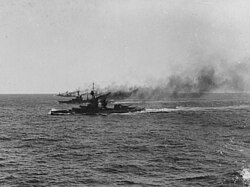The4th Battle Squadronwas asquadronof the BritishRoyal Navyconsisting ofbattleships.The 4th Battle Squadron was initially part of the Royal Navy'sHome Fleet(1912–14) and then theGrand Fleetafter the outbreak of theFirst World War.The squadron changed composition often as ships were damaged, retired or transferred.
| 4th Battle Squadron | |
|---|---|
 The ships of the 4th Battle Squadron,Benbow,Agincourt,Bellerophon,andTemerairesteaming in the North Sea, 1915. | |
| Active | 1912–30 March 1919;[1]reformed |
| Country | |
| Branch | |
| Size | Squadron |
| Part of | Home Fleet Grand Fleet |
August 1914
editOn 5 August 1914, the squadron was constituted as follows:[2]
January 1915
editBy January 1915, the composition had changed slightly:[2]
- HMSAgincourt
- HMSBellerophon
- HMSDreadnought
- HMSTemeraire
- HMSBenbow
- HMSEmperor of India
- HMSErin
Battle of Jutland, June 1916
editAs an element in theGrand Fleet,the squadron participated in theBattle of Jutland.During the battle, the composition of the 4th Battle Squadron was as follows:[3]
- Third Division
- HMSIron Duke,fleetflagshipofAdmiralSir John Jellicoe;CaptainFrederic Dreyer;
- HMSRoyal Oak,CaptainCrawford Maclachlan;
- HMSSuperb,flagship ofRear AdmiralA. L. Duff;Captain E. Hyde-Parker;
- HMSCanada,CaptainW. C. M. Nicholson;
- Fourth Division
- HMSBenbow,flagship ofVice AdmiralSirDoveton Sturdee;CaptainH. W. Parker;
- HMSBellerophon,CaptainE. F. Bruen;
- HMSTemeraire,CaptainE. V. Underhill;
- HMSVanguard,Captain J. D. Dick;
January 1917
editFollowing the Battle of Jutland, the 4th Battle Squadron was reorganized, withColossus,Hercules,St. Vincent,CollingwoodandNeptuneall transferred from the1st Battle Squadron.In January 1917, the squadron was constituted as follows:[4]
- HMSBellerophon
- HMSTemeraire
- HMSVanguard
- HMSSuperb
- HMSColossus
- HMSHercules
- HMSNeptune
- HMSSt. Vincent
- HMSCollingwood
After the loss of HMSVanguardin July 1917, HMSSuperband HMSTemerairewere detached to the Mediterranean in 1918. HMSDreadnoughtrejoined the squadron as flagship in March 1918.
Postwar
editThe squadron was dispersed in February 1919, appears to have been formally dissolved in March 1919, but then reformed.
In September 1920 Rear AdmiralRichard Webbwas posted to the Mediterranean as Rear-Admiral 4th Battle Squadron andSecond-in-Command, Mediterranean Fleet.He served there until 1922.[5]
Admirals commanding
editPost holders as follows:[6][1]
| Rank | Flag | Name | Term | Notes | |
|---|---|---|---|---|---|
| Admirals, Commanding, 4th Battle Squadron | |||||
| 1 | Vice-Admiral | SirSir Charles Briggs | 1 July 1912 – 1 July 1914 | ||
| 2 | Vice-Admiral | SirDouglas Gamble | 1 July 1914 – 7 February 1915 | ||
| 3 | Admiral | SirF. C. Doveton Sturdee | 7 February 1915 – 13 February 1918 | ||
| 4 | Vice-Admiral | SirMontague Browning | 13 February 1918 – 3 December 1918 | ||
| 5 | Rear-Admiral | Douglas R. L. Nicholson | 3 December 1918 – 1 February 1919 | temporary command | |
| 6 | Vice-Admiral | SirMontague Browning | 1 February 1919 – 1924 | ||
Rear-Admirals, Second-in-Command
editPost holders as follows:[1]
| Rank | Flag | Name | Term | Notes | |
|---|---|---|---|---|---|
| Rear-Admiral, in the 4th Battle Squadron | |||||
| 1 | Rear-Admiral | Alexander Duff | 22 October 1914 – 12 June 1916 | ||
| 2 | Rear-Admiral | Ernest F. A. Gaunt | 12 June 1916 – 23 June 1917 | ||
| 3 | Rear-Admiral | Roger J.B. Keyes | 23 June 1917 – 25 September 1917 | ||
| 4 | Rear-Admiral | Douglas R. L. Nicholson | 22 September 1917 – 3 December 1918 | acting squadron commander | |
| 5 | Rear-Admiral | Michael Culme-Seymour | 1 January 1919 – 1 September 1920 | ||
| 6 | Rear-Admiral | Richard Webb | 1 September 1920 – 27 July 1922 | ||
| 7 | Rear-Admiral | John D. Kelly | 27 July 1922 – June 1923 | ||
| 8 | Rear-Admiral | Hugh D. Watson | 26 June 1923 – October 1924 | ||
Notes
edit- ^abcHarley, Simon; Lovell, Tony."Fourth Battle Squadron (Royal Navy) – The Dreadnought Project".dreadnoughtproject.org.Harley & Lovell, 1 August 2017.Retrieved27 December2017.
- ^abDittmar & Colledge
- ^MacIntyre
- ^Dittmar & Colledgep. 20.
- ^"Senior Royal Navy appointments"(PDF).Archived fromthe original(PDF)on 15 March 2012.Retrieved4 October2014.
- ^"Senior Royal Navy appointments"(PDF).Archived fromthe original(PDF)on 11 July 2011.Retrieved4 October2014.
External links
editReferences
edit- Dittmar, Frederick J; Colledge, J. J. (1972).British Warships 1914–1919.London: Ian Allan Publishing.ISBN978-0-7110-0380-4.
- MacIntyre, Donald (1957).Jutland.London: Evans Brothers.ISBN978-0-330-20142-1.